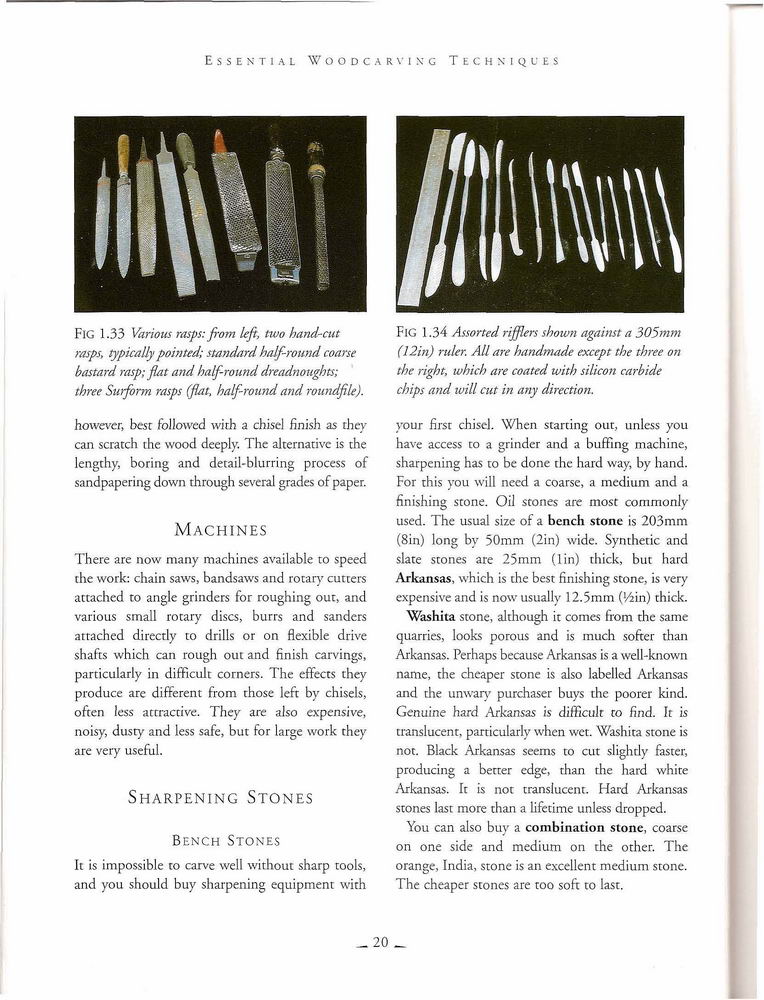essentÊrving°20

Essen tul W o o d c a r v i n g Techxiques
mm
FlG 1.33 Various rasps: from lefi, two hand-cut rasps, typically pointedstandard haif-round coarse bastard rasp; fiat and half-round dreadnoughts; three Surform rasps (fiat, half-round and roundfile).
however, bcst followed wirh a chiscl finish as they can scratch the wood deeply. The alternativc is the lengthy, boring and detail-blurring process of sandpapering down through sevcral grades of paper.
Machines
There are now many machines available to speed the work: chain saws, bandsaws and rotary cutters attached to anglc grinders for roughing out, and various smali rotary dises, burrs and sanders attached directly to drills or on flexible drive shafts which can rough out and finish carving$, particularly in difficult corners. The effects they produce are different from those left by chisels, often less attractivc. They are also expensive, noisy, dusty and less safe, but for large work they are very useful.
Sharpening Stones Bench Stones
It is impossible to carve well without sharp tools, and you should buy sharpening equipment with
FlG 1.34 Assorted rijfiers shown against a 305mm (12in) ruler. AU are handmade except the three on the right, which are coated with Silicon carbide chips and will cut in any direction.
your firsr chiscl. Whcn starting out, unlcss you have access to a grinder and a buffing machinÄ™, sharpening has to be done the hard way, by hand. For this you will necd a coarse, a medium and a finishing stone. Oil Stones are most commonly used. The usual sizc of a bench stone is 203mm (8in) long by 50mm (lin) wide. Synthetic and siatÄ™ stones are 25mm (lin) thick, but hard Arkansas, which is the best finishing stone, is very expensive and is now usually 12.5mm (tein) thick.
Washita stone, although it comes from the same quarrics, looks porous and is much softer than Arkansas. Perhaps because Arkansas is a weil-known name, the cheaper stone is also labelled Arkansas and the unwary purchaser buys the poorer kind. Genuine hard Arkansas is dilFicult to find. It is translucent, panicularly whcn wet. Washita stone is not. Black Arkansas seems to cut slighrly faster, producing a berter edge, than the hard white Arkansas. It is not translucent. Hard Arkansas stones last morÄ™ than a lifetime unless dropped.
You can also buy a combination stone, coarse on one side and medium on the other. The orange, India, stone is an excellent medium stone. The cheaper stones are too soft to last.
- 20 _
Wyszukiwarka
Podobne podstrony:
essent?rving?18 Essen tul Woodcarning Techniques Fig 1.29 A bench holdfast in use. Fig 1.28 A univer
essent?rving?40 Essen tial Woodcarying Techniques FlG 2.20 Arrow Crosstree (Dick Onians), carued in
essent?rving?48 Essen tiał Woodcarving Techxiques Fig 3.5 From the bot tom: two correct chip cuts; t
essent?rving?58 Essen-tial Woodcarvig Techxiques Fig 4.10 Cu tti fig the cup. The gouge en ten the w
essent?rving?68 Essen tial Woodcarving Techniques FlG 15.16 The fint cut into the serif on an M. Fig
essent?rving?08 Essen t i a l W o odcarvin c, T e c h n i q u e s Fic 1.5 Backbcnt. FlC 1.4 Left- an
essent?rving?16 Essen.tial Woodcarvmng Techsiques A clamp should be strong and have its heads in lin
essent?rving?30 Essen ti al Woodcarving Techniques Fig 2.4 A piece of Southern yeUow pine. The dark
essent?rving?34 Essen tial Woodcarying Techniques softwoods are evergreen and hardwoods are dcciduou
essent?rving?50 Essen tial W o o d c a r vin g Techniques Fig 3.11 Making the stab aa at too shallow
essent?rving?52 Essen’ tial W o o d c a r v i n g Techniques Fig 3.18 A No. 3 fishtail being used to
essent?rving?54 Essential Wo o d c a R VIN g Techniques Fic. 4.1 Various mouldings (from the top): a
essent?rving?66 Essen ti al Woodcarvixg Techniques Fig 5.1 Oak leafstudies by a student (Howard Spie
essent?rving?72 Essen tial Woodcarving Techniques although the temptarion ro use a router co set clo
essent?rving?78 Essential Woodcarving T e gh N 1 Q U E s FlG 6.9 Eigbteenth-century acanthus from a
essent?rving?86 Essen tial W o o d c a r vin g Tech kiqu es fold. If these arc forgotten irrcversibl
essent?rving?96 Essen ti al W o o dcaryinc T e c h niq u e s Fig S.18 Cutting across tbe gmin wbere
essent?rving?20 Essen tial Woodcarving T e c h n i q u e sChoosing the BestDlRECTION OF THE GRAIN Th
essent?rving?32 Essenti a i W o odcar yinc T k t h niq u e s Essenti a i W o odcar yinc T k t h niq
więcej podobnych podstron